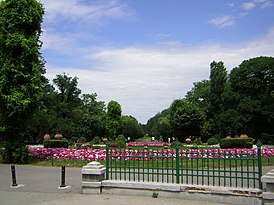Cișmigiu Gardens
| Cișmigiu Gardens (Cișmigiu Park) |
|
|---|---|
| Grădinile Cișmigiu (Parcul Cișmigiu) | |

View from the exit towards the park
|
|
|
Location of the park
|
|
| Location | Bucharest, Romania |
| Coordinates | 44°26′12.85″N 26°05′25.83″E / 44.4369028°N 26.0905083°E |
| Area | 16 hectares |
| Established | 1847 |
| Administered by | Administraţia Lacuri, Parcuri şi Agrement Bucureşti |
| Status | Open all year |
| Designers | Wilhelm Friedrich Carl Meyer, Franz Harer and Friedrich Rebhuhn |
| Website | cismigiuparc |
The Cișmigiu Gardens or Cișmigiu Park (Romanian: Grădinile Cișmigiu or Parcul Cișmigiu) are a public park near the center of Bucharest, Romania, spanning areas on all sides of an artificial lake. The gardens' creation was an important moment in the history of Bucharest. They form the oldest and, at 16 hectares, the largest park in city's central area. The main entrance is from Regina Elisabeta Boulevard, in front of the City Hall; there is another major entrance at the Știrbei Vodă Street, near the Crețulescu Palace. The southwestern corner of the park is adjacent to the Gheorghe Lazăr High School.
The Rondul Român ("Romanian Round") or Rotonda Scriitorilor ("Writers' Rotunda") is a circular alley which has stone busts of twelve important Romanian writers: Mihai Eminescu, Alexandru Odobescu, Titu Maiorescu, Ion Luca Caragiale, George Coșbuc, Ștefan Octavian Iosif, Ion Creangă, Alexandru Vlahuță, Duiliu Zamfirescu, Bogdan Petriceicu Hasdeu, Nicolae Bălcescu and Vasile Alecsandri.
Monumentul Eroilor Francezi ("The Monument of French Heroes") commemorates French soldiers who died fighting during the World War I Romanian Campaign. Made in Carrara marble the French monument was created by the Romanian sculptor Ion Jalea and was inaugurated at 25 October 1922. The sculptural work Izvorul Sissi Stefanidi, was created by Ioan C. Dimitriu Bârlad (1890–1964), and it depicts a mother, aggrieved by the death of her daughter, pouring water from a pitcher.
...
Wikipedia

